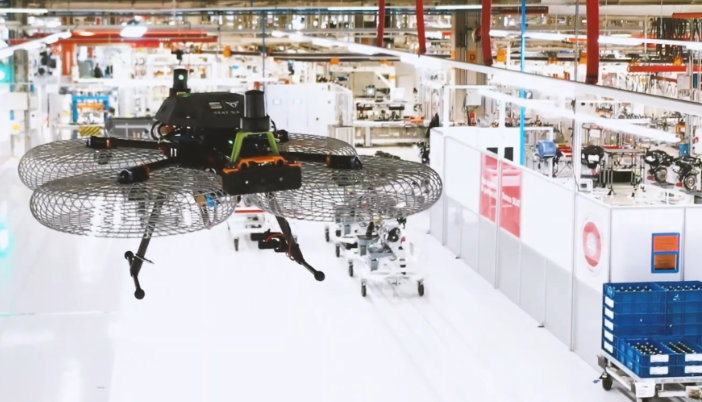In 2019, Spanish car maker SEAT S.A. partnered with Eurecat to explore using drones to optimize logistics supply, creating the “Drones in the Factory of the Future” project. Two years later, in 2021, the project had already logged 1,500 flight hours. Today, it continues to explore the opportunities and advantages of drone autonomous vertical navigation inside the factory to move light parts more quickly, sustainably, and efficiently.
To have drones flying indoors at its Martorell factory, SEAT had to develop a drone platform capable of autonomous navigation, see if it was feasible to transport material, and understand what it meant to on-site workers. Building a drone for this specific use case was a challenge. On the one hand, the drone had to be small and light. On the other, it also had to support all the required sensors and necessary protections to fly safely without posing a risk to employees.
SEAT dealt with indoor positioning as well as perception and mapping challenges by complementing the drone’s sensors with several sensors placed on various parts of the factory. By accurately positioning the drone inside the facility, it can easily map its surroundings and create trajectories in real-time to avoid fixed and mobile obstacles.
Finally, to ensure the drone doesn’t run out of battery power during flight, SEAT built a loading pad for a low-battery drone to land and charge its batteries autonomously. Additionally, the company created a hardware abstraction layer—an interface—to tell the drone which points to navigate around the factory.
Apart from optimizing logistics, the idea is to apply the solution to an entire fleet of indoor and outdoor drones programmed to fly autonomously without a remote control. Also, in 2019, SEAT carried out a pilot project under the Spanish Aviation Safety and Security Agency (AESA) supervision to set up a drone delivery service between two facilities. By connecting the two-kilometer distance separating both facilities, SEAT reduced delivery time from 90 minutes by truck to only 15 minutes by drone. The company believes reduced delivery times, more flexibility, efficiency, and environmental awareness are the advantages of using drones in the supply chain for the Martorell plant.
“Autonomous robots place us at the forefront of innovation in the automotive sector,” commented Herbert Steiner, SEAT Vice-President for Production and Logistics. “They’re also a clear example of how robots can collaborate with employees to make their work easier. Incorporating these robots contributes to driving Industry 4.0 and making us more efficient, flexible, agile, and competitive.”















Comments